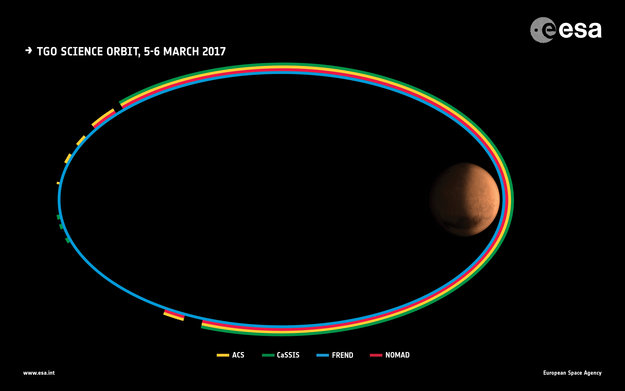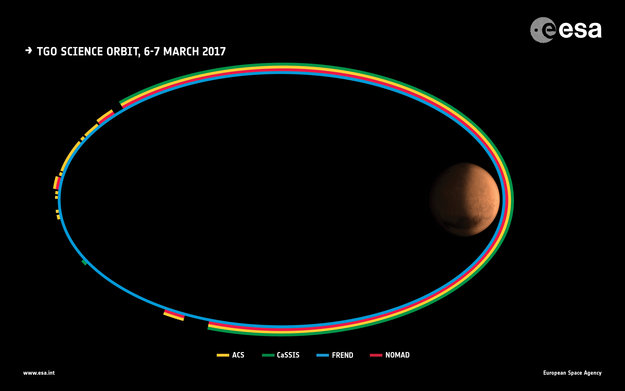http://www.esa.int/esl/ESA_in_your_country/Spain/El_orbitador_de_ExoMars_continua_con_las_pruebas_cientificas
El orbitador de ExoMars continúa con las pruebas científicas
1 marzo 2017
La semana que viene, el orbitador de ExoMars dedicará dos días a realizar importantes mediciones de calibración, necesarias para la fase científica de la misión que comenzará el próximo año.
El Satélite para el estudio de Gases Traza (TGO), fruto de la colaboración entre la ESA y Roscosmos, llegó al Planeta Rojo el 19 de octubre. Durante dos órbitas dedicadas el pasado noviembre, sus instrumentos científicos efectuaron las primeras mediciones de calibración desde su llegada a Marte, incluyendo imágenes del planeta y de una de sus lunas, Phobos, así como análisis espectrales de la atmósfera marciana.
En aquel momento, el orbitador estaba trazando una amplia elipse que lo llevó desde una altitud entre 230 y 310 km por encima de la superficie marciana hasta una distancia de 98.000 km cada 4,2 días.
La misión científica principal comenzará una vez alcance la órbita casi circular, a unos 400 km sobre el planeta, tras un año de ‘aerofrenado’ en el que hará uso de la atmósfera para decelerar y cambiar su órbita gradualmente.
A principios de este año, como preparación para la fase de aerofrenado, el TGO llevó a cabo una serie de maniobras para modificar casi 74º el ángulo de su trayectoria respecto al ecuador del planeta. Así, pasó de la órbita de llegada, casi ecuatorial, a una que más bien sobrevuela los hemisferios norte y sur.
Esta inclinación permitirá optimizar la cobertura de la superficie marciana por parte de los instrumentos científicos, manteniendo a la vez una buena visibilidad para retransmitir los datos de cualquier módulo de aterrizaje actual o futuro, incluido el robot explorador ExoMars que será lanzado en 2020.
No obstante, antes de que el 15 de marzo comience la fase de aerofrenado, que durará un año, los equipos científicos ahora vuelven a tener la oportunidad de realizar importantes mediciones de calibración, centrándose sobre todo en ensayos para comprobar la orientación y el seguimiento de los instrumentos, pero esta vez desde la nueva órbita.
La nueva órbita de una día del TGO va desde los 37.150 km en el punto más alejado hasta una distancia de 200 km de la superficie del planeta en el punto más cercano, lo que también permitirá tomar algunos de los primeros planos más cercanos de la misión.
Los dos conjuntos de espectrómetros del TGO efectuarán observaciones de calibración preliminares el 28 de febrero y el 1 de marzo, cuando los instrumentos de la nave estén mirando hacia Marte, mientras que la campaña principal tendrá lugar entre el 5 y el 7 de marzo y abarcará dos órbitas completas.
Durante la campaña principal, los espectrómetros podrán probar otro modo operativo, realizando un barrido hacia el horizonte con la luz del sol dispersada por la atmósfera.
Al observar cómo la luz es influida por la atmósfera, los científicos podrán analizar los componentes de la atmósfera marciana, que es el objetivo científico principal del TGO.
De hecho, la finalidad del TGO es realizar un inventario detallado de la atmósfera, en particular de aquellos gases presentes en cantidades mínimas. Resulta de especial interés el metano, que en la Tierra se produce sobre todo por actividad biológica o procesos geológicos, como ciertas reacciones hidrotermales.
La nave también buscará agua o hielo bajo la superficie, y ofrecerá imágenes contextuales en color y estereoscópicas de las formaciones superficiales, incluyendo aquellas que pudieran estar relacionadas con posibles fuentes de gases traza.
Durante las próximas observaciones, además de apuntar directamente a la superficie del planeta, la cámara realizará importantes mediciones de calibración del cielo oscuro y del campo estelar.
Entre tanto, el detector de neutrones del TGO permanecerá encendido durante las dos órbitas para calibrar el flujo de fondo.
“Es genial poder introducir estas importantes observaciones en el apretado programa de preparativos para la fase de aerofrenado —admite Håkan Svedhem, científico del proyecto TGO de la ESA—. Durante el aerofrenado, los equipos científicos podrán utilizar estas mediciones de calibración esenciales para optimizar los preparativos de cara a la misión principal, que comenzará al llegar a la órbita científica el año que viene”.
Para más información:
Markus Bauer
ESA Science and Robotic Exploration Communication Officer
Tel: +31 71 565 6799
Mob: +31 61 594 3 954
Email: markus.bauer@esa.int
ESA Science and Robotic Exploration Communication Officer
Tel: +31 71 565 6799
Mob: +31 61 594 3 954
Email: markus.bauer@esa.int
Håkan Svedhem
ESA ExoMars TGO Project Scientist
Email: hakan.svedhem@esa.int
ESA ExoMars TGO Project Scientist
Email: hakan.svedhem@esa.int
ENGLISH VERSION :
Science checkout continues for ExoMars orbiter
27 February 2017
Next week, the ExoMars orbiter will devote two days to making important calibration measurements at the Red Planet, which are needed for the science phase of the mission that will begin next year.
The Trace Gas Orbiter (TGO), a joint endeavour between ESA and Roscosmos, arrived at Mars on 19 October. During two dedicated orbits in late November, the science instruments made their first calibration measurements since arriving at Mars. These included images of Mars and one of its moons, Phobos, and basic spectral analyses of the martian atmosphere.
At that time, the orbiter was in a highly elliptical path that took it from between 230 and 310 km above the surface to around 98 000 km every 4.2 days.
The main science mission will only begin once it reaches a near-circular orbit about 400 km above the planet’s surface after a year of ‘aerobraking’ – using the atmosphere to gradually brake and change its orbit.
Earlier this year, in preparation for the aerobraking phase, TGO conducted a series of manoeuvres to shift its angle of travel with respect to the planet’s equator to almost 74º. This raised it from a near-equatorial arrival orbit to one that flies over more of the northern and southern hemispheres.
This inclination will provide optimum coverage of the surface for the science instruments, while still offering good visibility for relaying data from current and future landers – including the ExoMars rover scheduled for launch in 2020.
Now, before the year-long aerobraking phase begins on 15 March, the science teams once again have the opportunity to make important calibration measurements, focusing mainly on tests to check the pointing and tracking of the instruments, but this time from the new orbit.
The spacecraft’s new one-day orbit takes it from 37 150 km at its farthest and to within about 200 km of the planet’s surface at its closest approach, which will also allow some of the closest images of the mission to be obtained.
TGO’s two spectrometer suites will make some preliminary calibration observations on 28 February and 1 March while the spacecraft’s instruments are facing towards Mars, with the main campaign taking place 5–7 March, covering two complete orbits of the planet.
During the main campaign, the spectrometers will be able to test another operational mode, such as scanning towards the horizon at sunlight scattered by the atmosphere.
By looking at how the sunlight is influenced by the atmosphere, scientists will be able to analyse the atmospheric constituents of Mars – TGO’s main science goal.
Indeed, TGO is tasked with making a detailed inventory of the atmosphere, particularly those gases that are present only in trace amounts. Of high interest is methane, which on Earth is produced primarily by biological activity or geological processes such as some hydrothermal reactions.
The spacecraft will also seek out water or ice just below the surface, and will provide colour and stereo context images of surface features, including those that may be related to possible trace gas sources.
During the upcoming observations, and in addition to pointing directly at the planet’s surface, the camera will also take important dark sky and star field calibration measurements.
Meanwhile TGO’s neutron detector will be on throughout the two orbits in order to calibrate the background flux.
“It’s great we have the opportunity to squeeze in these important observations during this very busy time preparing for the year-long aerobraking phase,” says Håkan Svedhem, ESA’s TGO project scientist. “While the aerobraking is taking place, the science teams will be able to use these essential calibration measurements to best prepare for the start of the main mission when we arrive in our science orbit next year.”
For more information, please contact: Markus Bauer
ESA Science and Robotic Exploration Communication Officer
Tel: +31 71 565 6799
Mob: +31 61 594 3 954
Email: markus.bauer@esa.int
Håkan Svedhem
ESA ExoMars TGO Project Scientist
Email: hakan.svedhem@esa.int
ESA Science and Robotic Exploration Communication Officer
Tel: +31 71 565 6799
Mob: +31 61 594 3 954
Email: markus.bauer@esa.int
Håkan Svedhem
ESA ExoMars TGO Project Scientist
Email: hakan.svedhem@esa.int
For more information, please contact:
Markus Bauer
ESA Science and Robotic Exploration Communication Officer
Tel: +31 71 565 6799
Mob: +31 61 594 3 954
Email: markus.bauer@esa.int
Håkan Svedhem
ESA ExoMars TGO Project Scientist
Email: hakan.svedhem@esa.int
Markus Bauer
ESA Science and Robotic Exploration Communication Officer
Tel: +31 71 565 6799
Mob: +31 61 594 3 954
Email: markus.bauer@esa.int
Håkan Svedhem
ESA ExoMars TGO Project Scientist
Email: hakan.svedhem@esa.int
ESA
Guillermo Gonzalo Sánchez Achutegui



No hay comentarios:
Publicar un comentario